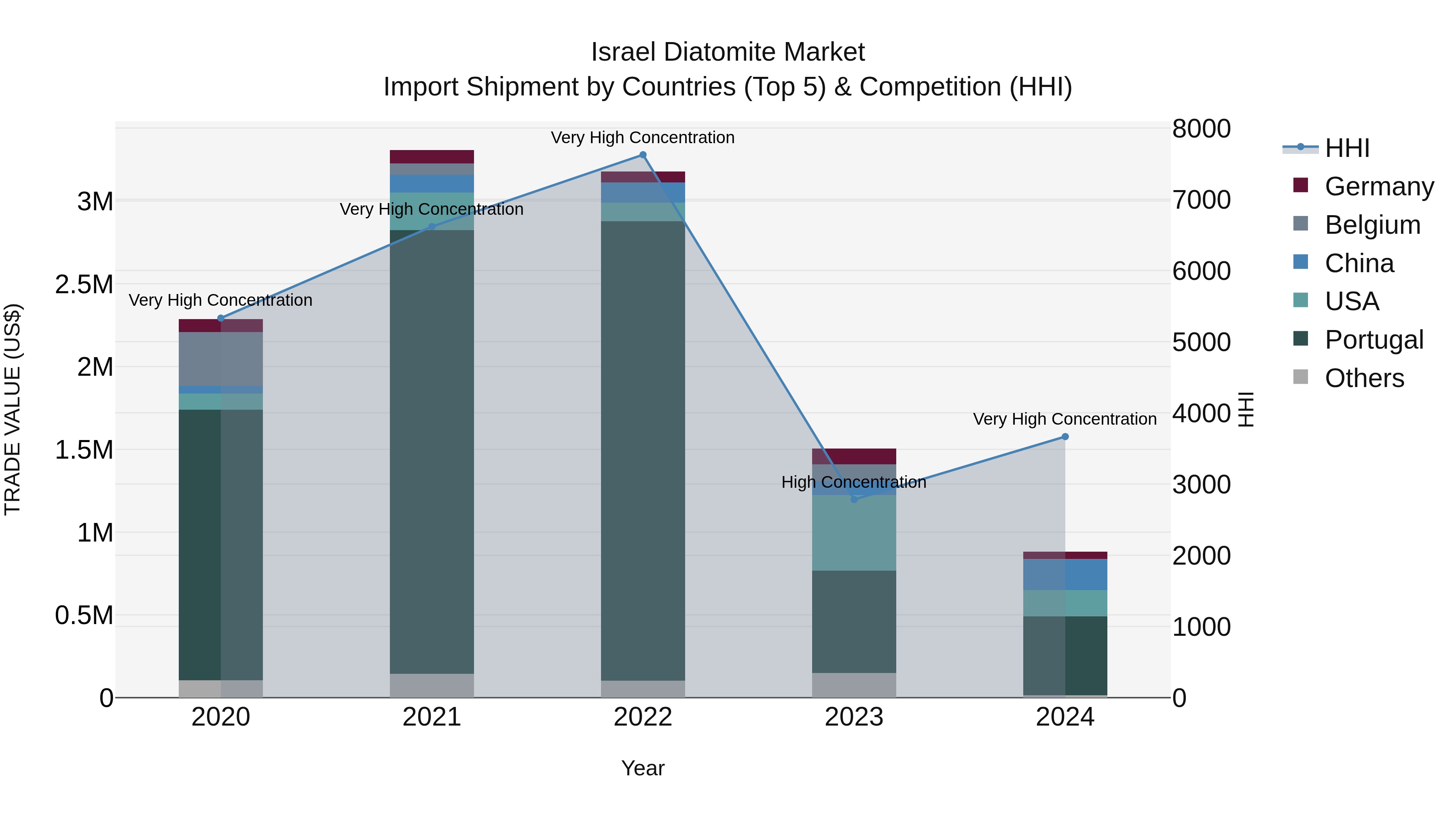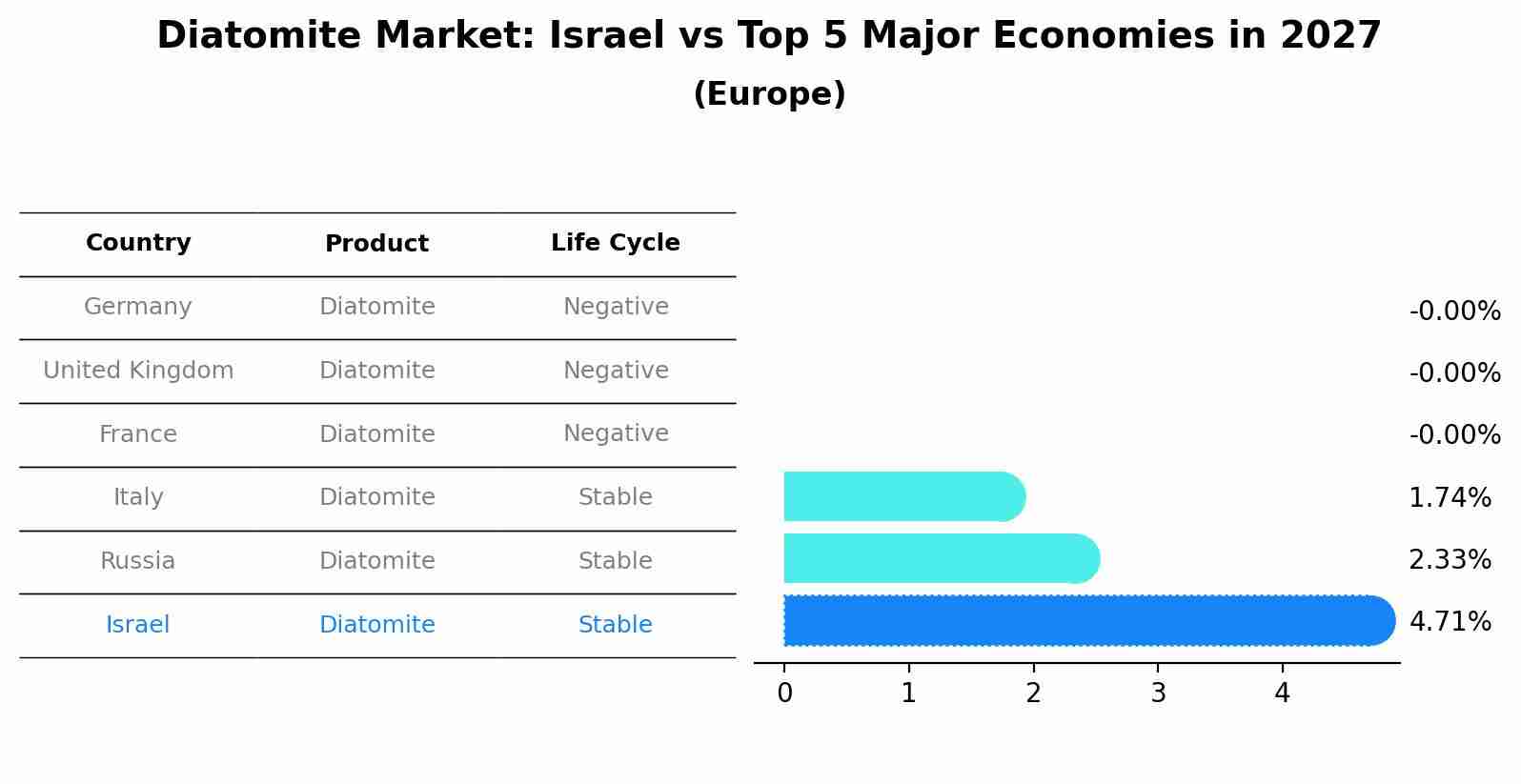Israel Diatomite Market (2025-2031) | Outlook, Analysis, Forecast, Revenue, Segmentation, Industry, Growth, Value, Companies, Share, Size & Trends
| Product Code: ETC5095411 | Publication Date: Nov 2023 | Updated Date: Nov 2025 | Product Type: Market Research Report | |
| Publisher: 6Wresearch | Author: Shubham Padhi | No. of Pages: 60 | No. of Figures: 30 | No. of Tables: 5 |
Israel Diatomite Market Top 5 Importing Countries and Market Competition (HHI) Analysis
In 2024, Israel saw a significant increase in diatomite import shipments, with top exporting countries being Portugal, China, USA, Germany, and Metropolitan France. The market exhibited very high concentration levels, indicating a competitive landscape dominated by a few key players. Despite a negative compound annual growth rate (CAGR) of -21.17% from 2020 to 2024, the industry experienced a steep decline in growth rate from 2023 to 2024 at -41.37%. This suggests a challenging environment for diatomite imports in Israel, requiring strategic adjustments and market analysis for sustainable business operations.

Diatomite Market: Israel vs Top 5 Major Economies in 2027 (Europe)
Israel's Diatomite market is anticipated to experience a stable growth rate of 4.71% by 2027, reflecting trends observed in the largest economy Germany, followed by United Kingdom, France, Italy and Russia.

Israel Diatomite Market Synopsis
Diatomite, a naturally occurring mineral, is used in filtration, insulation, and as an abrasive. The Israel diatomite market provides high-quality diatomaceous earth products for industrial and agricultural applications.
Drivers of the market
The Israel diatomite market is witnessing growth driven by increasing demand for sustainable filtration and absorbent solutions across various industries. Diatomite, a naturally occurring sedimentary rock composed of fossilized diatoms, is valued for its high porosity, absorbency, and filtration properties. Israel diatomite producers are capitalizing on these properties to develop innovative products for applications such as water treatment, agriculture, construction, and industrial filtration. Moreover, growing awareness of environmental sustainability and regulations promoting eco-friendly alternatives are driving the adoption of diatomite-based solutions, further fueling market growth in Israel.
Challenges of the market
Despite the wide range of applications for diatomite, market growth faces challenges related to environmental concerns and regulatory restrictions. Developing sustainable extraction practices and exploring new applications can mitigate these challenges.
Government Policy of the market
The diatomite market in Israel is influenced by government policies promoting sustainable resource management and environmental protection. Regulations ensuring the responsible extraction and utilization of diatomite drive the adoption of sustainable mining practices. Government initiatives providing incentives for investments in mineral exploration and supporting the development of eco-friendly industrial applications also contribute to market growth. Additionally, policies fostering innovation in diatomite processing and ensuring compliance with environmental regulations support the expansion of the diatomite market.
Key Highlights of the Report:
- Israel Diatomite Market Outlook
- Market Size of Israel Diatomite Market, 2024
- Forecast of Israel Diatomite Market, 2031
- Historical Data and Forecast of Israel Diatomite Revenues & Volume for the Period 2021-2031
- Israel Diatomite Market Trend Evolution
- Israel Diatomite Market Drivers and Challenges
- Israel Diatomite Price Trends
- Israel Diatomite Porter`s Five Forces
- Israel Diatomite Industry Life Cycle
- Historical Data and Forecast of Israel Diatomite Market Revenues & Volume By Type for the Period 2021-2031
- Historical Data and Forecast of Israel Diatomite Market Revenues & Volume By Natural for the Period 2021-2031
- Historical Data and Forecast of Israel Diatomite Market Revenues & Volume By Calcined for the Period 2021-2031
- Historical Data and Forecast of Israel Diatomite Market Revenues & Volume By Flux Calcined for the Period 2021-2031
- Historical Data and Forecast of Israel Diatomite Market Revenues & Volume By Application for the Period 2021-2031
- Historical Data and Forecast of Israel Diatomite Market Revenues & Volume By Filter Aids for the Period 2021-2031
- Historical Data and Forecast of Israel Diatomite Market Revenues & Volume By Filler for the Period 2021-2031
- Historical Data and Forecast of Israel Diatomite Market Revenues & Volume By Absorbents for the Period 2021-2031
- Historical Data and Forecast of Israel Diatomite Market Revenues & Volume By Construction Materials for the Period 2021-2031
- Historical Data and Forecast of Israel Diatomite Market Revenues & Volume By Others for the Period 2021-2031
- Israel Diatomite Import Export Trade Statistics
- Market Opportunity Assessment By Type
- Market Opportunity Assessment By Application
- Israel Diatomite Top Companies Market Share
- Israel Diatomite Competitive Benchmarking By Technical and Operational Parameters
- Israel Diatomite Company Profiles
- Israel Diatomite Key Strategic Recommendations
Frequently Asked Questions About the Market Study (FAQs):
1 Executive Summary |
2 Introduction |
2.1 Key Highlights of the Report |
2.2 Report Description |
2.3 Market Scope & Segmentation |
2.4 Research Methodology |
2.5 Assumptions |
3 Israel Diatomite Market Overview |
3.1 Israel Country Macro Economic Indicators |
3.2 Israel Diatomite Market Revenues & Volume, 2021 & 2031F |
3.3 Israel Diatomite Market - Industry Life Cycle |
3.4 Israel Diatomite Market - Porter's Five Forces |
3.5 Israel Diatomite Market Revenues & Volume Share, By Type, 2021 & 2031F |
3.6 Israel Diatomite Market Revenues & Volume Share, By Application, 2021 & 2031F |
4 Israel Diatomite Market Dynamics |
4.1 Impact Analysis |
4.2 Market Drivers |
4.2.1 Growing demand for diatomite in various applications such as filtration, agriculture, and construction industries |
4.2.2 Increasing awareness about the benefits of diatomite as a sustainable and eco-friendly material |
4.2.3 Rise in research and development activities for new applications of diatomite in industries like cosmetics and food beverage |
4.3 Market Restraints |
4.3.1 Fluctuating prices of raw materials impacting production costs |
4.3.2 Stringent regulations regarding mining and processing of diatomite |
4.3.3 Competition from alternative materials in the market |
5 Israel Diatomite Market Trends |
6 Israel Diatomite Market Segmentations |
6.1 Israel Diatomite Market, By Type |
6.1.1 Overview and Analysis |
6.1.2 Israel Diatomite Market Revenues & Volume, By Natural, 2021-2031F |
6.1.3 Israel Diatomite Market Revenues & Volume, By Calcined, 2021-2031F |
6.1.4 Israel Diatomite Market Revenues & Volume, By Flux Calcined, 2021-2031F |
6.2 Israel Diatomite Market, By Application |
6.2.1 Overview and Analysis |
6.2.2 Israel Diatomite Market Revenues & Volume, By Filter Aids, 2021-2031F |
6.2.3 Israel Diatomite Market Revenues & Volume, By Filler, 2021-2031F |
6.2.4 Israel Diatomite Market Revenues & Volume, By Absorbents, 2021-2031F |
6.2.5 Israel Diatomite Market Revenues & Volume, By Construction Materials, 2021-2031F |
6.2.6 Israel Diatomite Market Revenues & Volume, By Others, 2021-2031F |
7 Israel Diatomite Market Import-Export Trade Statistics |
7.1 Israel Diatomite Market Export to Major Countries |
7.2 Israel Diatomite Market Imports from Major Countries |
8 Israel Diatomite Market Key Performance Indicators |
8.1 Average selling price of diatomite products |
8.2 Number of patents filed for innovative diatomite applications |
8.3 Environmental sustainability metrics related to diatomite mining and processing |
8.4 Research and development investment in diatomite technologies |
9 Israel Diatomite Market - Opportunity Assessment |
9.1 Israel Diatomite Market Opportunity Assessment, By Type, 2021 & 2031F |
9.2 Israel Diatomite Market Opportunity Assessment, By Application, 2021 & 2031F |
10 Israel Diatomite Market - Competitive Landscape |
10.1 Israel Diatomite Market Revenue Share, By Companies, 2024 |
10.2 Israel Diatomite Market Competitive Benchmarking, By Operating and Technical Parameters |
11 Company Profiles |
12 Recommendations | 13 Disclaimer |
- Single User License$ 1,995
- Department License$ 2,400
- Site License$ 3,120
- Global License$ 3,795
Search
Thought Leadership and Analyst Meet
Our Clients
Related Reports
- Afghanistan Apparel Market (2026-2032) | Growth, Outlook, Industry, Segmentation, Forecast, Size, Companies, Trends, Value, Share, Analysis & Revenue
- Canada Oil and Gas Market (2026-2032) | Share, Segmentation, Value, Industry, Trends, Forecast, Analysis, Size & Revenue, Growth, Competitive Landscape, Outlook, Companies
- Germany Breakfast Food Market (2026-2032) | Industry, Share, Growth, Size, Companies, Value, Analysis, Revenue, Trends, Forecast & Outlook
- Australia Briquette Market (2025-2031) | Growth, Size, Revenue, Forecast, Analysis, Trends, Value, Share, Industry & Companies
- Vietnam System Integrator Market (2025-2031) | Size, Companies, Analysis, Industry, Value, Forecast, Growth, Trends, Revenue & Share
- ASEAN and Thailand Brain Health Supplements Market (2025-2031) | Strategy, Consumer Insights, Analysis, Investment Trends, Opportunities, Growth, Size, Share, Industry, Revenue, Segments, Value, Segmentation, Supply, Forecast, Restraints, Outlook, Competition, Drivers, Trends, Demand, Pricing Analysis, Competitive, Strategic Insights, Companies, Challenges
- ASEAN Bearings Market (2025-2031) | Strategy, Consumer Insights, Analysis, Investment Trends, Opportunities, Growth, Size, Share, Industry, Revenue, Segments, Value, Segmentation, Supply, Forecast, Restraints, Outlook, Competition, Drivers, Trends, Demand, Pricing Analysis, Competitive, Strategic Insights, Companies, Challenges
- Europe Flooring Market (2025-2031) | Outlook, Share, Industry, Trends, Forecast, Companies, Revenue, Size, Analysis, Growth & Value
- Saudi Arabia Manlift Market (2025-2031) | Outlook, Size, Growth, Trends, Companies, Industry, Revenue, Value, Share, Forecast & Analysis
- Uganda Excavator, Crane, and Wheel Loaders Market (2025-2031) | Strategy, Consumer Insights, Analysis, Investment Trends, Opportunities, Growth, Size, Share, Industry, Revenue, Segments, Value, Segmentation, Supply, Forecast, Restraints, Outlook, Competition, Drivers, Trends, Demand, Pricing Analysis, Competitive, Strategic Insights, Companies, Challenges
Industry Events and Analyst Meet
Whitepaper
- Middle East & Africa Commercial Security Market Click here to view more.
- Middle East & Africa Fire Safety Systems & Equipment Market Click here to view more.
- GCC Drone Market Click here to view more.
- Middle East Lighting Fixture Market Click here to view more.
- GCC Physical & Perimeter Security Market Click here to view more.
6WResearch In News
- Doha a strategic location for EV manufacturing hub: IPA Qatar
- Demand for luxury TVs surging in the GCC, says Samsung
- Empowering Growth: The Thriving Journey of Bangladesh’s Cable Industry
- Demand for luxury TVs surging in the GCC, says Samsung
- Video call with a traditional healer? Once unthinkable, it’s now common in South Africa
- Intelligent Buildings To Smooth GCC’s Path To Net Zero


















